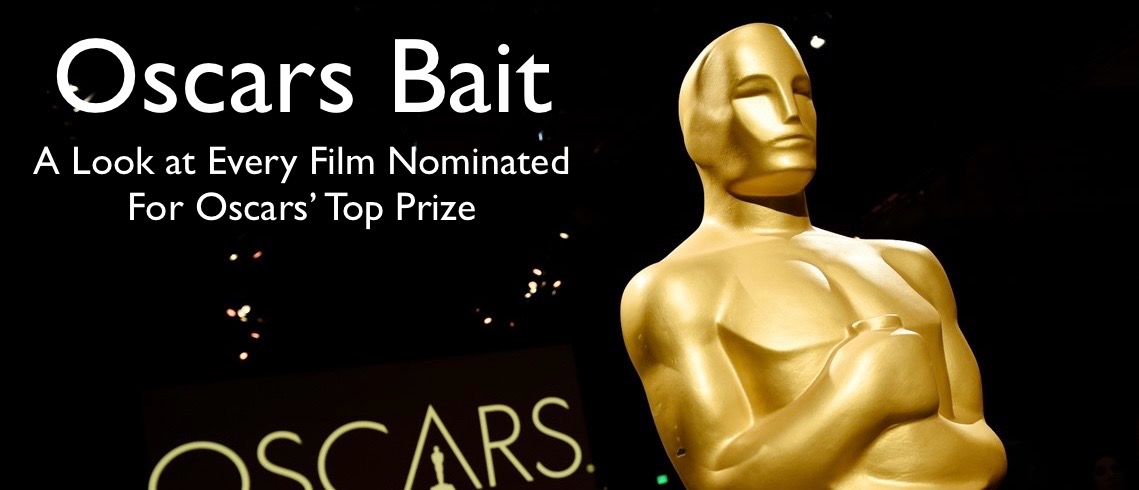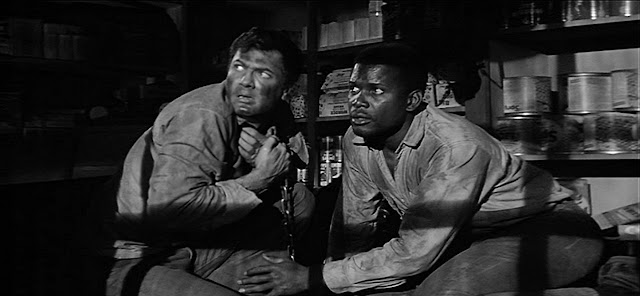When you sit down to write a film about overcoming racism, there are a couple of ways you can go about it. You can reverse the stereotype and make the minority character more civilized while the white character is pig-headed and ignorant. Or you can put two characters of different races together in a situation where they have to work together to stay alive and have them learn a lesson about racism along the way. Both methods have been done numerous times, often to great effect. Enemy Mine did this from a science fiction angle and remains a bona fide classic of the genre. Star Trek: The Next Generation did an episode where a human and a Romulan, enemies at the time, had to put aside their differences and rely on each other for survival. It’s a common trope that crops up all the time throughout cinema history.
Race relations are a tense subject with views ranging all the way from hatred towards other races to the naive, well-meaning but misguided, mentality of being colorblind. The latter mindset is noble but ignores the fundamental truths that while we are all members of the human race, there is a lot of diversity in that group, and to pretend there isn’t on the pretext of being the exact opposite of racist is not the right mentality, either. We as a species have a hard time accepting differences, and so a lot of people go to one extreme or the other when the best route is to accept those differences and not be bothered by or judge people by them. I’ve heard people counter Black Lives Matter with ALL Lives Matter as if they are trying to ignore the injustices done to so many African Americans in the country for the sake of inclusivity. Such an argument ignores the whole point of the Black Lives Matter movement, which is not saying that other lives do not matter. We, as a people, have come a long way since the days of segregation and slavery, but that doesn’t mean we are where we need to be just yet.
1958’s The Defiant Ones is a film that was made with a single purpose in mind: to show audiences that there is good and bad in everyone, not just one race or the other. Stanley Kramer liked to make movies with social context like this and would tackle the race issue again when making Guess Who’s Coming to Dinner nine years later, also starring Sidney Poitier. While Kramer was making a name for himself as a director of social issues, Poitier was finding himself pigeonholed as a Black actor who was the face of racial injustice. Films like these two as well as To Sir, With Love and In the Heat of the Night showcased an atypical, in the movies anyway, African American who was both smart and well educated facing racial stereotypes. Even The Defiant Ones, where his character isn’t necessarily an educated man, he is playing a convict whose punishment seems much more severe than the crime committed.
The setting is the 1950s, and a prison truck loaded with convicts is driving through the Southern United States. On board, amongst others, are two convicts: Noah Cullen (Sidney Poitier), a Black man, and John “Joker” Jackson (Tony Curtis), a White man. The men are shackled together ostensibly because the warden “had a sense of humor.” When the truck swerves off the road to avoid another truck, crashing through a guardrail and rolling off the side, Noah and Joker escape. This starts a manhunt that the officers don’t believe will take long as the general consensus is that the two men will not be able to cooperate with each other, maybe even kill each other, because of the difference in race. This belief is strengthened by an earlier scene just prior to the crash where the two come to blows after Joker hurls racial slurs at Noah.
What the officers, led by Sheriff Max Muller (Theodore Bikel), don’t count on is that, differences aside, these two men are determined to escape even if it means working with each other at least until they can break the chain that binds them together. Over the course of their escape attempt, both men will have opportunities to show their value to each other in more ways than one, as Noah knows roughly where the train lines are and when they can expect one to come along that they can hop on. Joker is better at making plans to get them out of jams, including how to escape a deep hole the two end up in that becomes nearly impossible to climb while their hands are chained to each other. By being forced together, Joker will also get a chance to see racism up close when the two encounter people who are more than eager to string them up and lynch them, collecting the reward for capturing and executing them. They only escape that grizzly fate thanks to some assistance from a former chain-gang prisoner named Big Sam (Lon Chaney Jr), who is appalled by the bloodlust he sees in his fellow workers.
Perhaps the most shocking moment in this film comes late in the game when Joker and Noah are taken in by an unnamed mother and her son. This part is so shocking because the film hides from us what is really going on until the last moment, tricking us into believing this woman, played to perfection by Cara Williams, is a benevolent person. She presents an opportunity for Noah to escape on his own while she and Joker use her car to evade the police, who are not looking for a man and woman couple. Her directions for Noah are designed to ensure he doesn’t survive, preventing him from giving up her and Joker’s own plans. This casual dismissal of Noah is far more appalling than anything Joker has said to Noah throughout the course of the film.
Speaking of Joker and his attitude towards Noah, we get a rather interesting moment shortly after the two make their initial escape. Noah calls Joker out for his racist comments, specifically for calling him the N-word. Joker goes on and on about how he doesn’t see it as racist and would have no problems if Noah were to call him a honkey. Justifying his use of the N-word, he says, “It’s what you are…You can call me a bull honkey, I won’t mind.” Joker’s response reminded me of a man in another film who was trying to soften his actions through the same kind of justification. Ben Chapman in the film 42 hurls hateful racist words at Jackie Robinson during a baseball game, then claims later it is all in good fun, like calling a fellow Jewish player The Kike. It’s a lame justification, and he knows it.
Joker, predictably, begins to see Noah as more than just his race. The man at the beginning of the film would not have risked his life and freedom to save Noah’s. That’s not the same man as the one who takes a bullet and runs after Noah to warn him of the treachery Cara William’s character has laid up for him. He gives up escape in order to save Noah’s life. When the two are recaptured, they end the film holding each other as if they are still chained together, Noah singing a song as they accept that they didn’t escape the law.
The message of the film is loud and clear: racism is stupid, and we’re all humans regardless of our skin color or background. This message, and the whole setup of the story, has been copied and parodied over and over again throughout the years. It’s a good concept, which explains why we still see elements of it in modern-day cinema. Bits of this setup can be seen in films like Die Hard With a Vengeance, Black Mama White Mama, as well as countless television episodes and even video games. It’s an important lesson that still needs to be taught. We’ve come a long way getting from there to here, but we still have a long way to go.
Academy Award Nominations:
Best Picture: Stanley Kramer
Best Director: Stanley Kramer
Best Actor: Tony Curtis
Best Actor: Sidney Poitier
Best Supporting Actor: Theodore Bikel
Best Supporting Actress: Cara Williams
Best Story and Screenplay - Written Directly for the Screen: Nedrick Young and Harold Jacob Smith (won)
Best Cinematography - Black-and-White: Sam Leavitt (won)
Best Film Editing: Frederic Knudtson
____________________________________________________
Release Date: September 27, 1958
Running Time: 96 Minutes
Not Rated
Starring: Tony Curtis, Sidney Poitier, Theodore Bikel, Charles McGraw, Lon Chaney Jr., King Donovan, Kevin Coughlin, and Cara Williams
Directed By: Stanley Kramer









Comments
Post a Comment